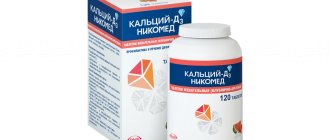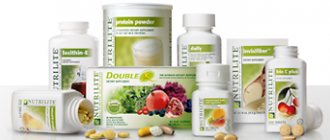Composition and release form
| Capsules | 1 caps. (0.5 g) |
| lutein | 4.5 mg |
| zeaxanthin | 0.5 mg |
| ginkgo biloba extract | 20 mg |
| taurine | 100 mg |
| vitamin A | 1650 IU |
| vitamin C | 50 mg |
| vitamin E | 15 mg |
| selenium (in yeast) | 25 mcg |
| copper (as sulfate) | 1.5 mg |
| chromium (as picolinate) | 50 mcg |
| zinc (as sulfate) | 7.5 mg |
10 pcs in blister; There are 3 blisters in a cardboard pack.
LUTEIN FORTE VITAMIR VITAMINS FOR EYES, TABLETS No. 30
A dietary supplement containing lutein and zeaxanthin, vitamins, and microelements that help maintain the normal functioning of the visual organs.
Lutein is a natural pigment that is very useful for the organs of vision, especially for the retina, is responsible for vigilance and prevents some age-related eye diseases. Lutein takes care of the condition of the eyes, maintains visual acuity, helps the visual analyzers adapt to sudden changes in light, and promotes the normal functioning of the visual organs.
Zeaxanthin is a carotenoid pigment. It is responsible for the health of the retina and its normal functioning. Zeaxanthin protects the organs of vision from harmful ultraviolet radiation and from the effects of free radicals, improves intercellular metabolic processes, and, consequently, nutrition of the eyes, strengthens the walls of blood vessels and capillaries of the organs of vision, improves visual acuity and color perception, keeps the eye muscles in good shape and relieves fatigue.
Vitamin C (ascorbic acid) is involved in carbohydrate metabolism and redox reactions. It stimulates collagen synthesis, tissue regeneration, and also improves capillary permeability, improves the condition of the fundus vessels, prevents increased eye pressure and hemorrhages in the retina. Vitamin C is a strong antioxidant, so it can stop the oxidative processes of visual pigments. Ascorbic acid maintains the mobility of the eye muscles and is responsible for preserving the functions of the optic nerve. Vitamin deficiency leads to rapid eye fatigue and poor vision.
Vitamin A regulates the functioning of the immune system and is one of the most effective vitamins for protecting vision. It is necessary for night vision, it moisturizes the cornea of the eyes, keeps it from dryness and damage
Vitamin E belongs to a class of antioxidants that neutralize free radicals in the body, which are one of the main causes of aging. Vitamin E is able to penetrate into cells and protect the integrity of cell membranes from damage by free radicals. It is involved in the functioning of all body systems.
Vitamin E reduces the progression of age-related vision degeneration, prevents retinal detachment, and supports eye function.
Rutin (Vitamin P) forms a group of substances called flavonoids. The high biological activity of flavonoids is due to the presence of antioxidant properties. Regular use of vitamin P normalizes the condition of capillary walls, increasing their strength and elasticity, and helps reduce intraocular pressure.
Zinc (Zn) is good for vision and is used to prevent eye diseases. Actively participating in biochemical processes, it helps to absorb vitamin A, which is necessary for normal eye function. Zinc deficiency leads to impaired color vision and the development of eye diseases.
Selenium (Se) is a powerful antioxidant, the deficiency of which can cause clouding of the eye lens, decreased visual acuity, and early development of cataracts. This is one of the components that converts the light signal into a nerve impulse. For better absorption, selenium must be taken together with vitamin E.
Component Properties
Lutein and zeaxanthin accumulate in the macula of the retina and protect it from the most aggressive, blue part of the daylight spectrum.
They partially reflect blue light from the central zone of the retina, where the light flux is most focused. In addition, lutein and zeaxanthin are able to absorb this part of the light spectrum and, being powerful antioxidants, suppress the formation of free radicals, which prevents retinal destruction and lens clouding.
Ginkgo biloba extract has antioxidant activity, as well as antihypoxic and cerebral circulation-improving effects. In addition, the components of the extract reduce the risk of thrombosis and reduce capillary permeability, which has a positive effect in diabetic retinopathy and other conditions accompanied by chronic ischemia of peripheral tissues.
Taurine is an amino acid. Participates in the transmission of photosignals, stimulates the regeneration and metabolism of eye tissue. Helps normalize the function of cell membranes and activate energy metabolic processes.
Vitamin A is involved in the metabolism of the visual pigment rhodopsin. The disintegration of this complex under the influence of light plays a significant role in the mechanism of the appearance of visual sensation (photosignal). The restoration of rhodopsin and an increase in its content in the retina ensures the adaptation of the eye to low light levels (dark adaptation).
Vitamin C has significant antioxidant activity; regulates the restoration of visual pigments, reduces increased intraocular pressure, reduces the risk of developing glaucoma.
Vitamin E accelerates the regeneration of damaged cells, participates in tissue respiration and other important processes of tissue metabolism. Prevents increased fragility and permeability of capillaries.
Selenium, copper, chromium, zinc are a complex of vital microelements that are a permanent component of the eye tissue and ensure its normal metabolism and restoration of cellular structures.
pharmachologic effect
Lutein and zeaxanthin
They are deposited in the central region (macula) of the retina and lens, endowed with the functions of a light filter, protecting important structures of the organ of vision from the particularly aggressive blue spectrum of daylight. They are powerful antioxidants that can neutralize free radicals and prevent the destruction of the retina with clouding of the lens.
Taurine
The amino acid is a participant in the transmission of photosignals and activates the metabolism and regeneration of eye tissue. Stimulates the normalization of cell membrane functions and promotes the activation of energy processes.
Ginkgo biloba extract
A powerful antioxidant with antihypoxic effect. Improves cerebral circulation, reduces the risk of thrombosis and reduces capillary permeability. Indispensable for diabetic retinopathy, as well as other conditions accompanied by ischemia of peripheral tissues.
Selenium, copper, chromium, zinc
Vital microelements are a permanent component of the eye tissue, which ensures its normal metabolism and restoration of structures.
Vitamin A
It is an obligatory component of the exchange of the visual pigment rhodopsin. Disintegrating under the influence of light, this complex plays an important role in the mechanism of formation of the visual sensation (photosignal). An increase in the content of rhodopsin in the retina ensures the adaptation of the eyes to low light levels (dark adaptation, twilight vision).
Vitamin C
An obligatory participant in reversible redox transformations, regulates the processes of restoration of visual pigments, reduces intraocular pressure, and reduces the risk of developing glaucoma. Is an antioxidant.
Vitamin E
Capable of activating the regeneration of damaged cells by participating in tissue respiration and other important processes of tissue metabolism. Protects against capillary fragility and permeability.
The retina and macula, its central part, have natural protection. This is a pigment layer that contains lutein and zeaxanthin (natural carotenoids). Lutein can be ingested exclusively through foods (fruits and vegetables), while zeaxanthin, in turn, is formed from lutein. The level of these components affects the condition of the retina and its health. To maintain good vision, a person should receive 5 mg of lutein daily, as well as 1 mg of zeaxanthin - this amount can be contained in 250 g of spinach, 1 kg of carrots, 0.5 kg of sweet pepper. The normal human diet contains less than 20% of this norm.
Radiation from computer and TV screens and intense light have a damaging effect on the macula, the most important area of the eye. Over time, this can lead to the development of a serious disease - age-related macular degeneration (AMD). AMD is the most common cause of blindness in the elderly. However, the incidence is rapidly becoming younger, and today people who have barely reached 50 years of age face it. Currently, it is impossible to cure this disease and a person completely loses vision due to atrophy of the optic nerve. Therefore, it is necessary to do everything possible to slow down the development of pathology, which Lutein Forte contributes to.
Reviews
Polina Lipetsk writes:
“My husband often works night shifts at the computer , which sometimes causes blood vessels to appear in his eyes and severe lacrimation.
Tearing was the problem that sent him to the ophthalmologist - changing lighting, strong winds, flashes of light - all this makes the eyes too wet.
In addition, my vision began to deteriorate . The doctor prescribed Lutein complex .
At first, my husband was skeptical, since he doesn’t really trust dietary supplements, but after two weeks of regular use, the problem was solved.
My work also involves a computer and so I decided to take these vitamins too .
I noticed that now my eyes don’t get so tired .”Zoya Moscow writes:
“Before my seven-year-old son entered first grade, we passed a medical examination. As a result, the child was diagnosed with initial myopia .
The doctor prescribed glasses for vision correction. After six months of school and daily reading, the child’s vision began to decline, and when it reached -4, we sounded the alarm.
The doctor recommended reducing time spent in front of the computer and tablet and prescribed Doppelherz vitamins , the same ones with two hearts on the package.
After the course, improvements were noticed - my son’s vision stabilized, and he stopped constantly rubbing his eyes out of fatigue .”
Natural sources
Vegetables and fruits
- Dark green vegetables - spinach, broccoli, collard greens, mustard leaves, horseradish leaves, green peas, green beans.
- Orange fruits and vegetables - citrus fruits (oranges, tangerines, grapefruit, etc.), peaches, apricots, melon. Orange vegetables rich in lutein include carrots, pumpkin, sweet potatoes and corn.
- Red vegetables and fruits (berries) - strawberries, raspberries, grapes, pomegranate. Vegetables: tomatoes, peppers, lettuce.
Need to know! A quick way to replenish your body's daily requirement of lutein is to drink a glass of tomato juice. 200 ml of drink contains the daily requirement of the substance - 6 mg.
You can eat vegetables both raw and prepared (boiled, baked, dried, etc.)
Other sources
- Egg yolks. Rich orange yolks indicate a high content of this substance, so try to eat these chicken eggs. Most often they can be bought at farms.
- Oatmeal – 1 serving of ready-made oatmeal contains 0.42 mg of this substance.
- Marigolds - more precisely, a pigment extracted from them, widely used in the food industry. It travels a long way before entering the human body. African marigold powder is added to poultry feed to make the skin color less pale and the yolks brighter.
What is lutein?
For reference! Lutein is an organic pigment that is found in varying degrees in many living organisms.
Its main function is the absorption of ultraviolet radiation.
In the human body, lutein is found in the eyes, or more precisely, in the area that is responsible for central vision (the macula).
A person
can get it by eating highly pigmented vegetables, fruits and greens (red, yellow, dark green) and some animal products, in particular eggs.
Indications for use
Note! Ophthalmologists recommend taking this vitamin to patients of the following categories:
- Elderly, for the prevention of senile lens opacification;
- Diabetics;
- Smokers;
- Persons suffering from reduced visual acuity in the twilight;
- Patients with cataracts;
- People who spend a lot of time at the computer;
- Survivors of retinal surgery;
- Suffering from myopia.
It is advisable to consult an ophthalmologist before taking vitamins to find out what caused the sudden deterioration in vision.
List of popular drugs
Keep in mind! Below is a list of the best drugs that contain large amounts of lutein:
- Lutein complex. Recommended for people who work at computers, drivers, as well as people suffering from dry eye syndrome and myopia. The drug contains lutein, taurine, copper, zinc, blueberry extract, selenium, beta-carotene, vitamins A, E, C. The course of administration is a month, 1-3 tablets per day.
- Okuwait lutein forte. It is used to improve the nutrition of the tissues of the eyeballs, as well as to prevent decreased visual acuity, retinal dystrophy and cataracts. The drug is also used comprehensively in the treatment of most ophthalmological diseases. The drug contains lutein, zinc, selenium, zeaxanthin, vitamins C and E. You need to take the drug for a month, 1 tablet per day.
- Doppelhertz Active . It is recommended for people whose work involves working in the dark or in bright light, as well as for the prevention of the development of myopia, retinal degeneration and cataracts. One capsule of the drug contains the daily requirement of this vitamin - 6 mg, zeaxanthin, zinc and vitamins A, E, B. Dosage regimen - 1 capsule per day with meals for 30 days.
- Blueberry Forte with lutein. Recommended by ophthalmologists as an effective preventive agent in the treatment of ophthalmic diseases and to improve visual acuity. Contains lutein, blueberry extract, B vitamins and zinc. Dosage regimen: 2 tablets twice a day for adults, children over 7 years old - 1 tablet 3 times a day, children of primary preschool age (from 3 to 7) - one tablet twice a day. The treatment regimen is from 2 to 4 months, according to the doctor’s recommendations.
- Strix forte. Recommended for eye fatigue syndrome, hemeralopia and during the recovery period after surgery. The drug contains this substance, blueberry extract, zinc, selenium, vitamins A and E. Dosage regimen: 1 tablet per day for 30 days.




